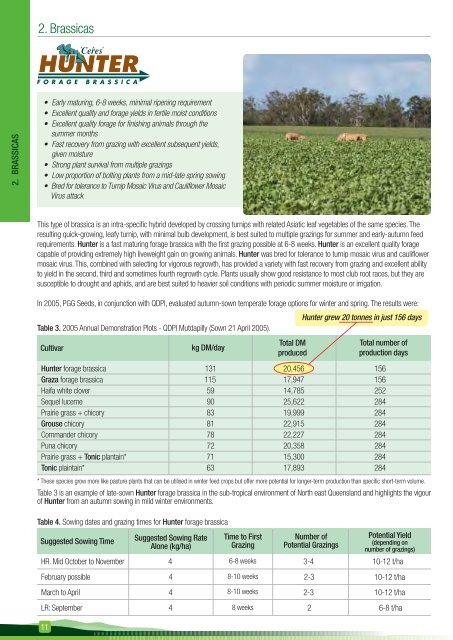Brassica Reference Manual - Agricom
Brassica Reference Manual - Agricom
Brassica Reference Manual - Agricom
Create successful ePaper yourself
Turn your PDF publications into a flip-book with our unique Google optimized e-Paper software.
2. BRASSICAS<br />
2. <strong>Brassica</strong>s<br />
This type of brassica is an intra-specific hybrid developed by crossing turnips with related Asiatic leaf vegetables of the same species. The<br />
resulting quick-growing, leafy turnip, with minimal bulb development, is best suited to multiple grazings for summer and early-autumn feed<br />
requirements. Hunter is a fast maturing forage brassica with the first grazing possible at 6-8 weeks. Hunter is an excellent quality forage<br />
capable of providing extremely high liveweight gain on growing animals. Hunter was bred for tolerance to turnip mosaic virus and cauliflower<br />
mosaic virus. This, combined with selecting for vigorous regrowth, has provided a variety with fast recovery from grazing and excellent ability<br />
to yield in the second, third and sometimes fourth regrowth cycle. Plants usually show good resistance to most club root races, but they are<br />
susceptible to drought and aphids, and are best suited to heavier soil conditions with periodic summer moisture or irrigation.<br />
In 2005, PGG Seeds, in conjunction with QDPI, evaluated autumn-sown temperate forage options for winter and spring. The results were:<br />
Hunter grew 20 tonnes in just 156 days<br />
Table 3. 2005 Annual Demonstration Plots - QDPI Mutdapilly (Sown 21 April 2005).<br />
Total DM<br />
Total number of<br />
Cultivar<br />
kg DM/day<br />
produced<br />
production days<br />
Hunter forage brassica 131 20,456 156<br />
Graza forage brassica 115 17,947 156<br />
Haifa white clover 59 14,785 252<br />
Sequel lucerne 90 25,622 284<br />
Prairie grass + chicory 83 19,999 284<br />
Grouse chicory 81 22,915 284<br />
Commander chicory 78 22,227 284<br />
Puna chicory 72 20,358 284<br />
Prairie grass + Tonic plantain* 71 15,300 284<br />
Tonic plaintain* 63 17,893 284<br />
* These species grow more like pasture plants that can be utilised in winter feed crops but offer more potential for longer-term production than specific short-term volume.<br />
Table 3 is an example of late-sown Hunter forage brassica in the sub-tropical environment of North east Queensland and highlights the vigour<br />
of Hunter from an autumn sowing in mild winter environments.<br />
Table 4. Sowing dates and grazing times for Hunter forage brassica<br />
Suggested Sowing Time<br />
Suggested Sowing Rate<br />
Alone (kg/ha)<br />
Time to First<br />
Grazing<br />
Number of<br />
Potential Grazings<br />
Potential Yield<br />
(depending on<br />
number of grazings)<br />
HR. Mid October to November 4 6-8 weeks<br />
3-4 10-12 t/ha<br />
February possible 4 8-10 weeks 2-3<br />
10-12 t/ha<br />
March to April 4 8-10 weeks<br />
2-3 10-12 t/ha<br />
LR: September 4 8 weeks<br />
2 6-8 t/ha<br />
11


